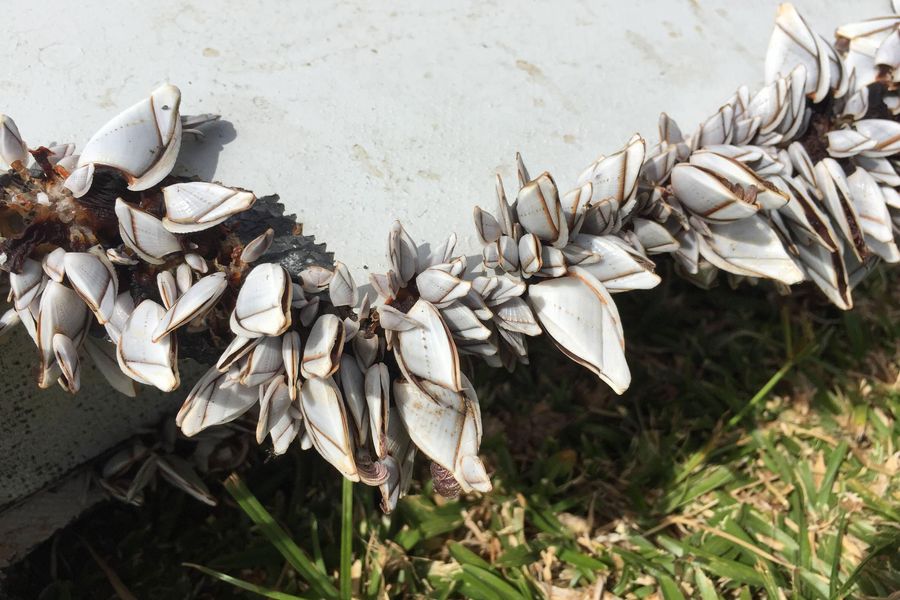First or the first year and a half after it vanished on March 8, 2014,
Better still, the flaperon carried with it evidence that may help locate the plane and solve the mystery once and for all: a population of gooseneck barnacles called
The flaperon and its Lepas spurred a decade of fruitful worldwide research into a previously obscure organism and unlocked the creature’s potential to serve as a natural data logger in all kinds of investigations, from tracking “ghost nets” that endanger wildlife to finding missing boats and even investigating
As someone who has been publicly obsessed with MH370 for a decade, I have spent a long time exploring the fine points of Lepas biology, most recently on my podcast. These are fascinating creatures. In their larval stage, they swim free as plankton throughout the world’s oceans. Then once they’re ready for adulthood, they start looking for a floating object to attach themselves to. Having found one, they explore it, looking for an ideal spot — they prefer a deep, shady location far from the waterline — and glue their heads in place, using fine, sievelike appendages to sweep food particles from the water. Because they evolved to settle on biodegradable material such as logs and clumps of seaweed, they grow quickly and can reach maturity in a matter of weeks. On man-made objects that don’t decay,
Since Lepas tends to colonize any floating object, scientists say the oldest barnacles on it will reflect the total amount of time that object has
Scott Bryan, a researcher at Queensland University of Technology in Australia, has studied how Lepas and other marine organisms settle on pieces of pumice that have been ejected into the ocean by volcanic explosions. Because the pumice starts out molten hot, and hence sterile, it offers a blank slate of sorts for biologists to study how the populations of organisms on floating debris change over time. “We find biological recruitment to be very quick, beginning within about two weeks,” Bryan told me. “Goose barnacles are one of the first colonizers.”

Once they settle, these populations are pretty robust. Although they do have predators on the open sea, such as sea turtles and nudibranchs, a kind of marine invertebrate, researchers say the barnacles generally get completely wiped out only if their host is washed ashore, where they will dry out and be picked clean by scavengers. “If there is nothing older than two months growing on it, we would interpret this to mean the pumice had not been floating in the ocean for more than three months,” Bryan says, allowing a margin of a few weeks for the organisms to become attached.
Scientists can tell the oldest and newest barnacles apart by measuring their size, which correlates with the length of time the animal has been growing on an object. This can be combined with “drift modeling,” which uses historical data about the drift paths of research buoys to create probabilistic estimates of a floating object’s origins. Martin Stelfox, founder of the Olive Ridley Project, a sea-turtle conservation program, has used Lepas barnacles to figure out where wildlife-ensnaring fishing gear has drifted from. “It’s a fairly reliable way to give you an idea of how long that gear has been drifting,” he says. “We can then use that age estimate to plug into things like drifting current models and start to backtrack to where potentially this gear may have come from.”
What researchers didn’t know back in 2015 was what a six-, 12-, or 18-month-old barnacle in the subtropical Indian Ocean would look like. In the years following the flaperon’s discovery, researchers tried growing barnacles in the lab and on buoys at sea and found that Lepas grows at different rates and winds up at different sizes depending on the temperature of the water and how much there is to eat. One team that looked at how Lepas grew in the cold waters of the Humboldt Current off the coast of Chile found that, after three months, the Lepas had stopped growing, at about 20 millimeters in length. Another studied a related species growing in the warmer waters of southeastern Australia and found they had gotten as large as 48 millimeters in as little as a month.
Conditions in the waters where the flaperon floated seem to lie somewhere in between. In 2020, Stelfox and his colleagues published the results of an experiment in which they had grown Lepas on buoys in the Maldives. They found that after 105 days of growth, or three and a half months, the largest of the shells was 35 millimeters — very close to the size of the biggest barnacle on the flaperon. The waters the buoys
It isn’t just the size of the shell that tells a story but also its chemical composition, which varies depending on the temperature of the water the Lepas is floating in when it lays down a given layer. This technique has been applied to the flaperon’s barnacles several times over the past decade. In the most recent study, published last year, a team led by Kuwait University researcher Nasser Al-Qattan analyzed a barnacle shell provided by the French authorities. The shell was relatively small, about 25 millimeters, which meant it was “only several months in age,” according to the study. Its chemistry indicated the creature had started growing in relatively warm water of 80 degrees before drifting into cooler water of around 75 degrees. “Its recorded drift reveals that the MH370 flaperon likely spent its last several months west of longitude 70°E and within 1,500 km of Réunion Island,” the researchers concluded. That’s over 1,000 miles from the MH370 search zone.
